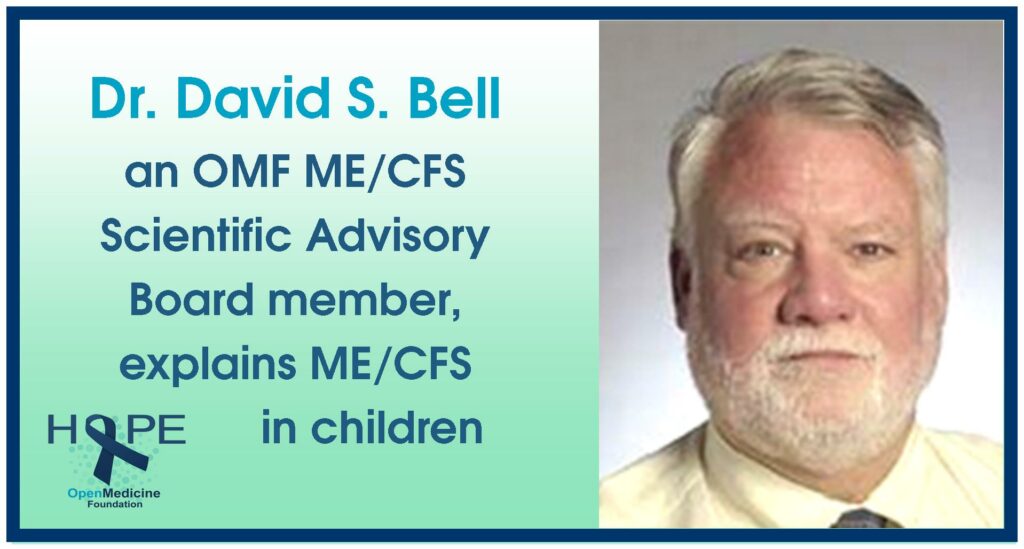 Myalgic Encephalomyelitis (ME)/ Chronic Fatigue Syndrome (CFS) is a chronic illness with a long and complex history. Estimates of its frequency range from 0.1% to 2% of the population in the United States1. Severity of the illness can range from trivial, where it is impossible to make the diagnosis to fatal, but this latter is, fortunately, rare. At present, the diagnosis is entirely clinical and based upon symptom presentation and pattern2. However there are numerous research laboratory tests that are close to being accepted as diagnostic markers for the illness.
Myalgic Encephalomyelitis (ME)/ Chronic Fatigue Syndrome (CFS) is a chronic illness with a long and complex history. Estimates of its frequency range from 0.1% to 2% of the population in the United States1. Severity of the illness can range from trivial, where it is impossible to make the diagnosis to fatal, but this latter is, fortunately, rare. At present, the diagnosis is entirely clinical and based upon symptom presentation and pattern2. However there are numerous research laboratory tests that are close to being accepted as diagnostic markers for the illness.
ME / CFS has been accepted as a serious chronic illness by the Centers for Disease Control (CDC)3 and the National Institutes of Health (NIH). Recently, the Institute of Medicine (IOM) conducted an exhaustive review of ME / CFS and published their findings4.
The many symptoms of ME / CFS are easy to describe: they resemble the exhaustion, headache, and malaise of the first day of the flu. Every healthy person has experienced this and knows that in a day or two, it will pass. But these symptoms do not pass in ME / CFS. Perhaps the hallmark symptom is post-exertional malaise, and for this reason the IOM recommended the name Severe Exertion Intolerance Disease, SEID4.
Diagnosis in Children
For the most part ME / CFS can only be diagnosed in adolescents and older individuals. Children below the age of 8 or 9 do not have the symptom pattern of adolescents past puberty. If the onset of the disease occurs during adolescence, the most common time of onset, the pattern is similar to that of adults. Pediatric criteria have been developed5,6.
Pediatric Symptoms
The onset is usually acute with an illness resembling mononucleosis, but unlike normal mono, it does not resolve in two to three weeks. Instead, the exhaustion, headache, muscle and joint pain, sore throat and lymph node pain become chronic. Exertion, even as seemingly minor as getting on a school bus may trigger a relapse causing the child to have to spend prolonged periods in bed. But not all children describe post-exertional malaise7. In general, the more severe the symptoms are in the first six months, the less likely to be resolution of the illness over time8. It has been my belief, although never proven in clinical studies, that an adolescent who spent the first three months in bed due to ME / CFS will still be ill at age 35, even though they may have been almost well in the years in between.
Of the many problems here, of course, is that no one has ever studied and published these issues in adolescents. It is impossible to predict at the onset of the disease if a teen has a standard viral infection or the beginning of a severe course of ME / CFS. In general, ME / CFS is a post-infectious phenomenon. The other great problem is that there is no simple laboratory test that can identify the presence or the severity of ME / CFS. Essentially all of the symptoms are subjective, and cannot be measured without subjective bias. It is comparable to the severity of a migraine headache. Normally, when someone says they have a migraine headache, we take their word for it, as it cannot easily be proven. But for ME / CFS, medical providers are reluctant to take the adolescent’s word for the presence of the symptoms.
Instead, providers usually suggest that the symptoms are not that bad, and that some exercise or counseling can remove them. Counseling is useful if an adolescent is coping poorly, and mild exercise can be of use when someone with the illness is improving spontaneously. But too often it precipitates a relapse, which is why the IOM suggested the name Severe Exertion Intolerance Disease4.
There are minor differences between adolescent ME / CFS and the adult ME / CFS. One is that abdominal pain is more common5 while this symptom is not even a part of some adult symptom criteria3. In addition, facial flushing is more common in teens9. I recall once when walking down the street in Lyndonville, I saw a teen with bright red facial flushing. He became ill within one or two days and remained ill for years. I made the mistake once of calling this a rash, but it is not a rash, it is flushing – the same as an adult can have when taking niacin. In some of the early outbreaks, this flushing rash is also mentioned and considered a standard symptom, one that involves the autonomic nervous system, as this part of the nervous system controls the diameter of the blood vessels.
Onset Prior to Puberty
I have seen many children where the parent will state that the child became ill at age 3. What the parent means by this statement is that, in retrospect, they can say that they noticed problems starting at age 3, but not that the whole symptom pattern was present. They may have noticed that their child was sleeping more than usual, or that their child seemed to get sick with viral infections more often than healthy kids. Children at a young age do not understand the concept of tiredness, because this word can only be used in reference to a state of good energy. If someone has never had prolonged ‘good energy’ the word fatigue has no meaning.
However during adolescence the symptom pattern coalesces into that of ME / CFS, so that it becomes possible to say that ‘in retrospect’ the illness began in early childhood. The cognitive symptoms from age 3 to age 12 are indistinguishable from attention deficit disorder, and this is another area that has never been adequately studied.
Activity Level
A great amount of confusion concerning ME / CFS revolves around the symptoms which constitute this disease as a distinct entity. Most of the symptoms, for example, are common to many illnesses, such as fatigue, headache and so on. However three are not: persistence of reduced activity, post-exertional malaise, and orthostatic intolerance. It has long been my belief that persistence of reduced activity is the most important of the three. However these symptoms are not easy for the affected child or teen to describe.
One way to measure the severity of both reduced activity and orthostatic intolerance is to ask: “How much time, in a 24 hour day, are you able to be ‘up and around?’” Activities which are not part of ‘up and around’ would include sleeping, resting or watching TV. Activities which are part of functional activity would be homework, attendance at school or social activities, reading while sitting up, and of course, any out of the house activities. A questionnaire designed to measure overall activity is available10. In an adolescent who is functional for more than eight hours in a day, the diagnosis of ME / CFS is very difficult to make. Very severe ME / CFS patients usually have less than 2 hours a day of functional activity, even adding together the fifteen minute segments.
Prognosis
When the child or adolescent comes to the medical practitioner, they look well, and this generates the false impression of factitious illness. In fact, the diagnosis of the illness depends upon this appearance of good health. Improvement of the activity level of a teen with the disease is the best marker of illness status11.
One study of young adults followed for fifteen years demonstrated clear improvement in activity, but not illness resolution8. The same group of patients continued to do relatively well for a further five to ten years and then became worse in both activity limitation and symptom severity12. It is rare for an adolescent to become completely free of the disease13.
Certain symptoms predict a more severe prognosis. These include a gradual onset, orthostatic intolerance, and cognitive difficulties, although this has never been adequately studied.
Treatment
Medical provider approach is very important. Without support, the adolescent will not return to a provider nor follow through with treatment suggestions. When confrontation is necessary it must be done with support. The medical provider must understand that the pediatric ME / CFS patient has likely been through a very tough time.
An understanding of PEM (post exertional malaise) is essential. I would often ask how much difficulty would this appointment cause in the coming week? This question tells the patient that the provider understands the hidden post-exertional malaise, and causes the patient to begin planning activities. Activity planning is essential, and only the patient can know how much exertion to do without precipitating a relapse.
I often encourage the family to purchase the Institute of Medicine book4, and have extra copies available to skeptical medical providers. It does not seem correct to ask patients to educate their providers, but so far nothing else has been effective.
Symptom management with standard and over-the-counter medication can be useful. Symptoms that can be helped include insomnia and pain, and for the adolescent with hypersomnia instead of insomnia, gentle, or low dose stimulants. Antidepressants are useful if there is concomitant depression, and benzodiazepines can be useful for concomitant anxiety. Vitamins, in my experience, have little value, but if a patient wants to explore this untested world, I rarely object, but caution against excessive expectations.
The amount of exercise is dependent upon many factors, and is best managed by the patient who has good knowledge of his/her limits. Teaching the ME / CFS patient between ‘good’ exercise where there is a feeling of invigorating energy, and ‘bad’ exercise where the teen feels ill from the exertion is important.
Education
Education is a crucial area for the provider to ‘treat’. As ME / CFS is a long term disease, future living and occupational opportunities are education-dependent. For a young teen, I would joke with them that it is unlikely that they would become a professional athlete. The provider must be involved with the schools from the beginning of their relationship with the patient, and home tutoring should be scheduled at the time of day when cognitive and orthostatic symptoms are mildest, usually in early afternoon, but sometimes mornings. Schools may offer one or two hours a week of tutoring and this is clearly inadequate. Families need to be aggressive and find individualized educational supports, such as books on disc, and on-line educational materials14.
Lack of diagnosis must be remedied immediately, and roughly 80% of adults have never been diagnosed15. Without a diagnosis, the school personnel assume absences are due to truancy, and children have been placed in foster care inappropriately. Referrals to social services are pursued because of the false diagnosis of Munchausen’s by Proxy. However for this diagnosis to be made evidence showing proof of the Proxy’s intention to harm the child must be presented16.
School absences because of ME / CFS are common and may be prolonged. In one study, the most common reason for long tern school absence was ME / CFS17.
The Most Effective Treatment
By far the most effective treatment is that the provider understand the disease and be supportive of the patient by advice or medications which assumes acceptance of the severity yet is accurate concerning emotions. As an example I would offer this anecdote. A twelve year old boy was seen for his first visit and as he came down the hall, he was dragging his left leg. I did a careful history and a careful physical exam. When we were finished I said that he had two diagnoses: 1) ME / CFS and 2) hysterical neurosis. “What?” he said, incredulous, “You are like everyone else who does not believe that this illness is real”
I answered, “I am very sure you have ME / CFS, and that it is a real disease, and that your activity is impaired. But you do not need to drag your leg when you walk. That is the only thing you are making up.”
After a bit he said, “OK, but I do that because no one believes I am sick.”
I said, “No one will believe you are ill because of your leg. In fact it will just make it harder for you in the future. You need to understand that at this time doctors do not accept or believe in ME / CFS, and you need to accept this as a present reality and get on with your life.” He did just that and immediately stopped limping. Over the next few years he did well and returned to good activity, about 75% of normal activity. And he did understand that no one would believe his illness – he dropped the self-pity and became realistic about his future.
Children and teens feel that they have to prove their illness to medical providers, and that is not possible.
In Conclusion
ME / CFS is a common and important disease in childhood and adolescents and is poorly studied and understood. What is often disregarded as a minor neurotic expression has lifelong effects. It is a tragedy that many of the severe sequelae of this disease can be avoided by appropriate diagnosis, activity monitoring, and education. Research in the mechanism of illness is limited and pediatric treatment research is nearly non-existant. As a caring and compassionate society, we must increase our efforts in these areas; at the very least we should be able to adequately diagnose young people with activity limitations.
References:
- Reyes, M., et al. Prevalence and incidence of Chronic Fatigue Syndrome in Wichita, Kansas. Arch Intern Med 163, 1530-1536 (2003).
- Jason, L., et al. A case definition for children with Myalgic Encephalomyelitis / Chronic Fatigue Syndrome. Clinical Medicine: Pediatrics 1, 1-5 (2008).
- Fukuda, K., et al. The Chronic Fatigue Syndrome: a comprehensive approach to its definition and study. Ann Intern Med 121, 953-959 (1994).
- IOM. Beyond Myalgic Encephalomyelitis / Chronic Fatigue Syndrome: redefining an illness, (Institute of Medicine; National Academies Press, Washington, DC, 2015).
- Jason, L., et al. A Pediatric Case definition for Myalgic Encephalomyelitis and Chronic Fatigue Syndrome. J CFS 13, 1-44 (2006).
- Bell, D. Chronic Fatigue Syndrome in children and adolescents: a review. Focus & Opinion: Pediatrics 1, 412-420 (1995).
- Jason, L., et al. Issues in Estimating Rates of Pediatric Chronic Fatigue Syndrome and Myalgic Encephalomyelitis in a Community-Based Sample. Avicenna Journal of Neuro Psych Physiology (2015).
- Bell, D., Jordan, K. & Robinson, M. Thirteen-year follow-up of children and adolescents with Chronic Fatigue Syndrome. Pediatrics 107, 994-998 (2001).
- Bell, D. & Bell, K. Chronic Fatigue Syndrome: diagnostic criteria [Letter]. Ann Intern Med 109, 167 (1988).
- Bell, D. (ed.) The Doctor’s Guide to Chronic Fatigue Syndrome, (Perseus Books, Reading, MA, 1993).
- Jason, L., King, C., Frankenberry, E. & KM., J. Chronic Fatigue Syndrome: assessing symptoms and activity level. J Clin Psychol 55, 411-424 (1999).
- Brown, M., Brown, A. & Jason, L. Illness duration and coping style in Chronic Fatigue Syndrome. Psychological Reports 106, 383-393 (2010).
- Rangel, L., Garralda, M., Levin, M. & Roberts, H. The course of severe Chronic Fatigue Syndrome in childhood. Journal of the Royal Society of Medicine 93, 129-134 (2000).
- Arzomand, M. Chronic Fatigue Syndrome among school children and their special educational needs. J Chronic Fatigue Synd 4, 59-69 (1998).
- Jason, L., Richman, J., Rademaker, A. & al, e. A community-based study of Chronic Fatigue Syndrome. Arch Intern Med 159, 2129-2137 (1999).
- Ayoub. Definitional Issues in Munchausen’s syndrome by Proxy. Child Abuse and Neglect 11, 7-10 (2003).
- Dowsett, E. & Colby, J. Long-term sickness absence due to ME / CFS in UK schools: an epidemiological study with medical and educational implications. JCFS 3, 29-42 (1997).
Learn More:


